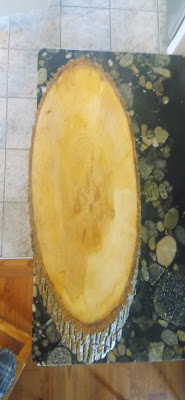First a photograph showing the two tools from the last blog. The large sander is more than twice the weight of the 4 1/2 angle grinder. However it spins slower and is not inclined to burn the wood.
Sunday, May 21, 2023
A Live Edge Bowl
Sunday, May 14, 2023
Grinder and Sander - compared
This morning I set out to do a blog comparing the 4 1/2 grinder with sanding disk to a 7 inch sander with a sanding disk.
Both are great tools, sadly I can't show you any pictures of my tools because the computer doesn't feel like letting me load photos today. I am assured that I am the problem. However, it could be a software problem, or a hardware problem with my camera: or a software problem or a hardware problem with my computer or.....a software problem or hardware problem with my router or something in the system, but it seems I lack understanding and unreasonableness for expecting digital technology to be reliable. This is why I like working with wood, no bull shit.
I found the 4 1/2 inch grinder spins so quickly that it is a trick not to get burn marks on the wood, The big old seven inch disk sander removes lots of material, in a hurry but does leave swirl marks to be sanded away later.
If one were to finally die, I would replace it immediately. Unlike digital technology these are two tools I can count on.
cheers ianw
Thursday, May 4, 2023
Kerfing plane/saw
Followers know I have a shop full of tools and yet something I like to do is make more tools. When I make a tool it connects me to the roots of the craft and because am retired I can spend time navel gazing without worrying about a production deadline. Actually I just turned 65 years old and had the joy of my prescription drugs plummeting in price, so retired and lucky too.
Anyway I digress. I have seem a variety of kerfing plane/saw plans on the net for years. In the past I was able to cut rebates and dadoes on my router table or table saw just fine actually, very accurately and efficiently. Now I like to fool around with hand tool projects and so decided I wanted an accurate way to cut consistent rebates by hand. The solution is the purpose made plane/saw.
My tool uses a saw blade rather than a plane blade.
Monday, May 1, 2023
Basic Woodworking?! with sanders
Sometimes making nice things is quite easy. If you have really good raw materials and don't get crazy you can get a fine result with almost no skill.












